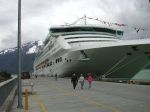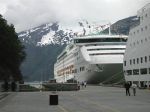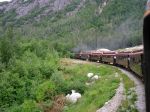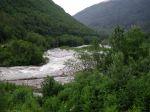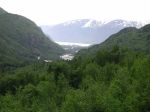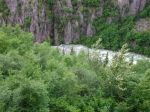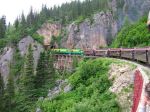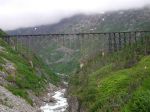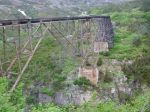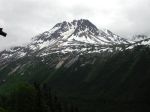
» » A Charles & Mieko Simon Web Site, ©2001 « «
Welcome to Our Web Site
Skagway, Alaska
This was the coldest 4th of July we had ever experienced! The wind was whipping down the pier between the mountains on the right as shown by these first two photographs and the ships tied to the wharf. We didn't make it to the parade that Skagway has every year on our Independance Day. Well, maybe next time. By the way, the parade is reported to be very good, lots fun. We found that it was much warmer, down right cozy in fact, on board the ship.
To help with the celebrating of the 4th, this British registered ship had this fine decoration in the atrium.
Skagway has an unique place in the history of Alaska. Skagway was the Alaskan starting point for those seeking their fortune during the 1898 Gold Rush. They were called “stampeders”. Ships loaded to capacity with men, a few women, horses, dogs, equipment and supplies anchored at Skagway where everyone was responsible for getting their own self and goods ashore. From Skagway, they made their way over the White Pass to enter the Yukon Territory. Entering the Yukon came with a price, each stampeder had to show to the Canadian Mounted Police that they had 2,000 pounds of provisions. All 2,000 pounds had to be carried, 65 pounds at a time, on the back of the stampeder. The trek to the Yukon took months and the snows and winds of the winter did not stop. The hardships that these people went through is unimaginable. I came across a very interesting book that documents this effort by photographs and words. Those interested in this part of American history will enjoy “The Klondike Quest” by Pierre Berton.
Our trip up the White Pass was much easier than those who traveled in 1898. We took the White Pass Railway to the border that divides Alaska from the Canadian Yukon. It follows, for the most part, the Skagway River. This river carries a gray silt indicating that it is fed by a glacier. A beautiful trip where one can see first hand the difficulties that awaited those making the trip on foot. The bridge shown here is not suitable for use now. It is an interesting structure demonstrating a cantilever truss design.
Skagway has a very interesting history as it played a very big role in the Gold Rush on 1897-98.
To learn more visit this National Park Service site
All photographs copyright 2001, Charles R. Simon
